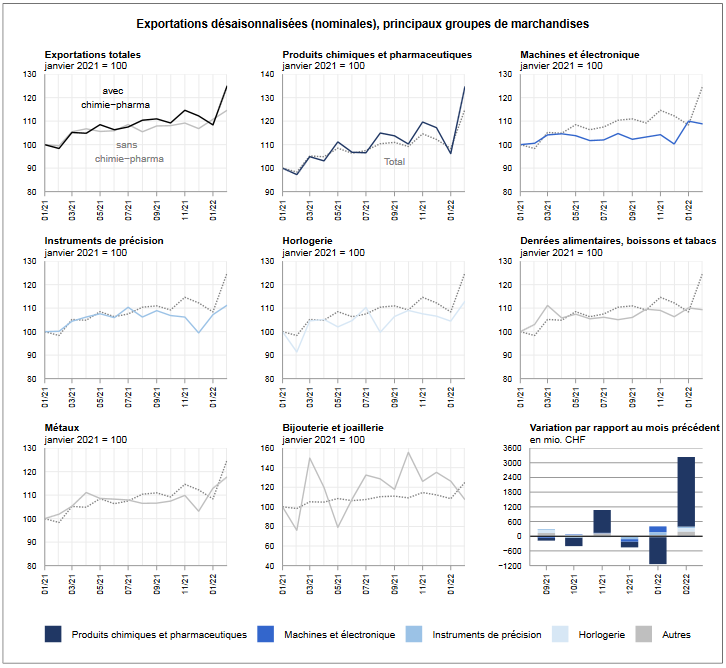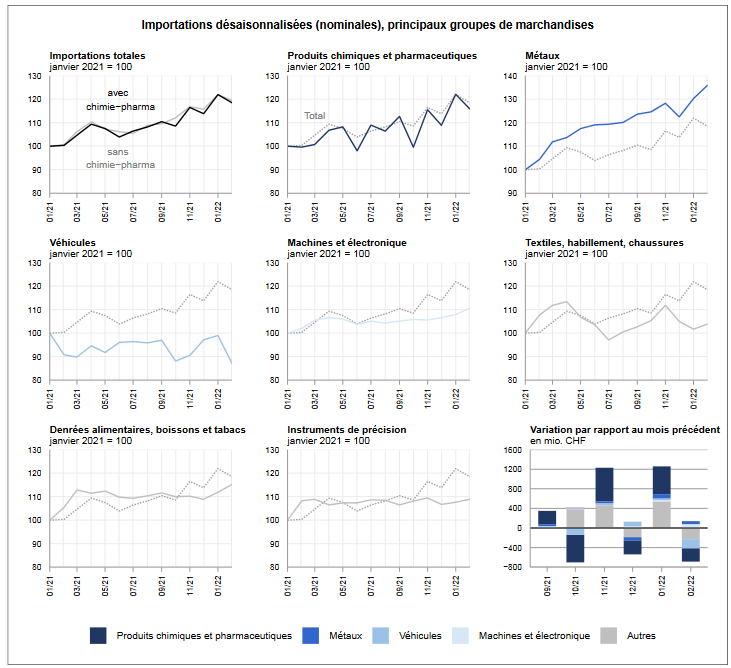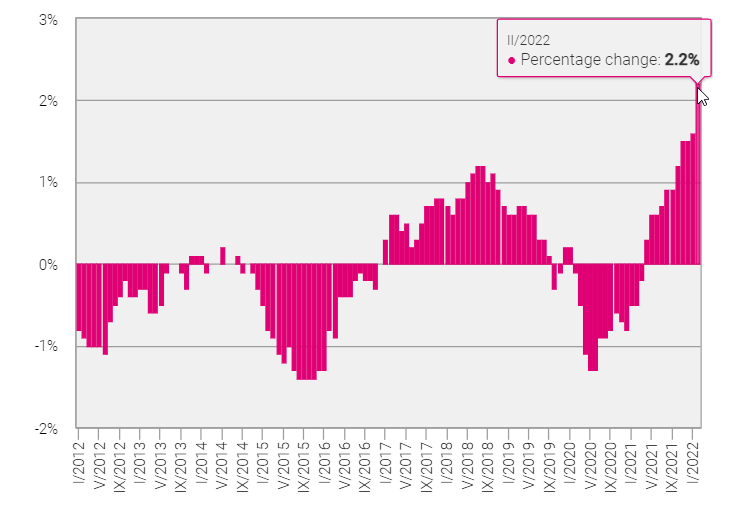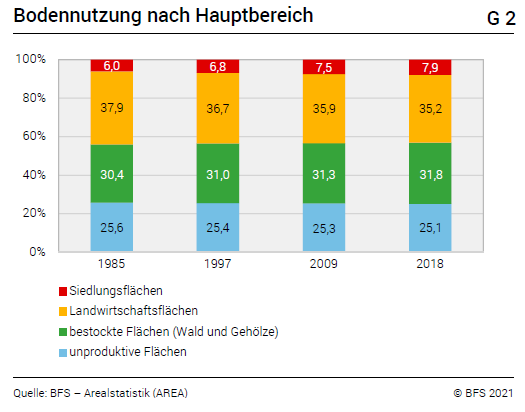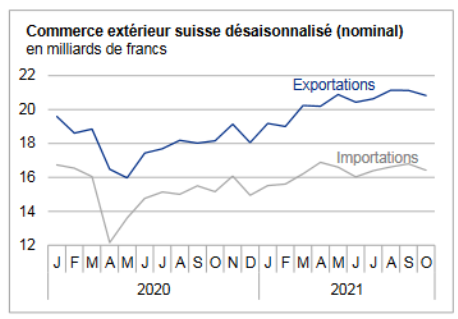We do not like Purchasing Power or Real Effective Exchange Rate (REER) as measurement for currencies. For us, the trade balance decides if a currency is overvalued. Only the trade balance can express productivity gains, while the REER assumes constant productivity in comparison to trade partners. Who has read Michael Pettis, knows that a rising trade surplus may also be caused by a higher savings rate while the trade partners decided to spend more. This is partially true. Recently Europeans started to increase their savings rate, while Americans reduced it. This has led to a rising trade and current surplus for the Europeans. But also to a massive Swiss trade surplus with the United States, that lifted Switzerland on the U.S. currency manipulation watch list. To
Topics:
Swiss Customs considers the following as important: 2.) Trade Balance News Service Bunt [FR], 2) Swiss and European Macro, Featured, newsletter
This could be interesting, too:
Nachrichten Ticker - www.finanzen.ch writes Die Performance der Kryptowährungen in KW 9: Das hat sich bei Bitcoin, Ether & Co. getan
Nachrichten Ticker - www.finanzen.ch writes Wer verbirgt sich hinter der Ethereum-Technologie?
Martin Hartmann writes Eine Analyse nach den Lehren von Milton Friedman
Marc Chandler writes March 2025 Monthly
We do not like Purchasing Power or Real Effective Exchange Rate (REER) as measurement for currencies. For us, the trade balance decides if a currency is overvalued. Only the trade balance can express productivity gains, while the REER assumes constant productivity in comparison to trade partners.
Who has read Michael Pettis, knows that a rising trade surplus may also be caused by a higher savings rate while the trade partners decided to spend more. This is partially true. Recently Europeans started to increase their savings rate, while Americans reduced it. This has led to a rising trade and current surplus for the Europeans. But also to a massive Swiss trade surplus with the United States, that lifted Switzerland on the U.S. currency manipulation watch list.
To control the trade balance against this “savings effect”, economists may look at imports. When imports are rising at the same pace as GDP or consumption, then there is no such “savings effect”.
After the record trade surpluses, the Swiss economy may have turned around: consumption and imports are finally rising more than in 2015 and early 2016. In March the trade surplus got bigger again, still shy of the records in 2016.
Swiss National Bank wants to keep non-profitable sectors alive
Swiss exports are moving more and more toward higher value sectors: away from watches, jewelry and manufacturing towards chemicals and pharmaceuticals. With currency interventions, the SNB is trying to keep sectors alive, that would not survive without interventions.
At the same time, importers keep the currency gains of imported goods and return little to the consumer. This tendency is accentuated by the SNB, that makes the franc weaker.
Texts and Charts from the Swiss customs data release (translated from French).
| In February 2022, seasonally adjusted exports jumped 15.4% – after their setback in the previous two months – while imports fell 2.9%. The output boom was driven by the strength of chemicals and pharmaceuticals. For the first time, the trade balance surplus passed the 5 billion franc mark.
In short ⇑After three declines in a row, watch sales jumped 8.1% ⇑Exports to North America up by half ⇑US imports climb 9.2% ⇓Nominal one-fifth drop in imports of energy products |
Swiss exports and imports, seasonally adjusted (in bn CHF), February 2022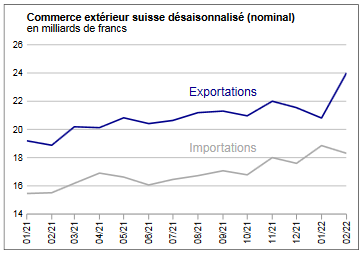 - Click to enlarge |
Global developmentIn February 2022, seasonally adjusted exports posted impressive growth of 15.4% compared to the previous month (actual: +8.1%), an unprecedented performance in recent decades. Imports contracted by 2.9% (actual: –0.9%) after surging the previous month. Due to the disparate evolution at the exit and the entry, the trade balance jumped to 5.7 billion francs, thus reaching a record surplus. |
Switzerland Trade Balance, February 2022(see more posts on Switzerland Trade Balance, )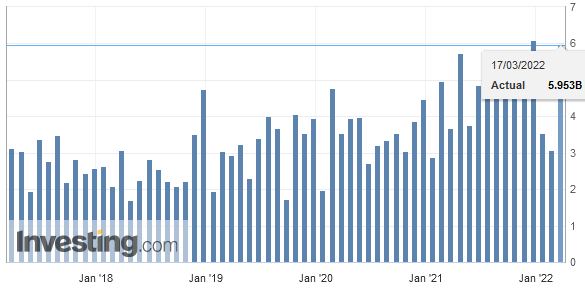 Source: investing.com - Click to enlarge |
| Drug exports increase by 1.5 billion francs over one month
The strong increase in exports in February 2022 can be attributed exclusively to chemicals and pharmaceuticals. Here, drug sales have literally exploded (+1.5 billion francs; +43.5%). Comparatively, immunological products and active ingredients experienced a less marked increase (+133 respectively +97 million francs). Watches (+8.1% or +151 million), vehicles, metals and precision instruments, among others, progressed. Jewelery and jewelery (–15.0%; –140 million francs) as well as the machinery and electronics sector (–1.1%; –30 million francs), on the other hand, suffered a setback. After its plunge in January 2022, turnover with North America increased by 52.1%, posting at the same time a record monthly level of 5.5 billion francs. This performance was based on the USA (above all chemicals-pharmaceuticals). To Europe and Asia, sales increased by 825 and 67 million francs respectively (+6.5% and +1.4%). On the Old Continent, growth mainly concerned the euro zone (+7.4%), in particular Germany, France and Spain. To the Asian continent, deliveries to China increased by 243 million francs (+19.1%). |
Swiss Exports per Sector February 2021 vs. 2020 |
| Imports: energy products, pharmaceuticals and vehicles weigh down the result
The drop in entry resulted from the underperformance of three commodity groups. Arrivals of energy products suffered the heaviest setback (–18.4% or –364 million francs). These had further swelled by more than a third the previous month (primarily the price effect). In chemical and pharmaceutical products, the fall was 5.2% (-273 million francs). Medicines suffered particularly, down by a fifth or 431 million francs; the previous month, however, these had increased by a third. Imports of vehicles – in particular aeronautics – lost 12.2% (–186 million francs). Those of the machinery and electronics sector as well as metals increased by 73 and 66 million francs, thus confirming their positive trend. From a geographical perspective, imports from Europe (–5.4% or –746 million francs) and Asia (–3.1% or –116 million francs) drank the cup, while those from North America (+6.2% or +75 million francs) gained ground. In the latter, the USA swelled by a tenth over a month (+102 million francs). In Europe, Germany, Austria, Spain and France dragged down the result, with a cumulative decline of 890 million francs. The Netherlands, on the other hand, jumped by 194 million francs. On the Asian side, shipments from South Korea, Singapore and the United Arab Emirates fell by a total of 182 million francs. Conversely, those of China and Japan have progressed. |
Swiss Imports per Sector February 2021 vs. 2020 |
Tags: Featured,newsletter

